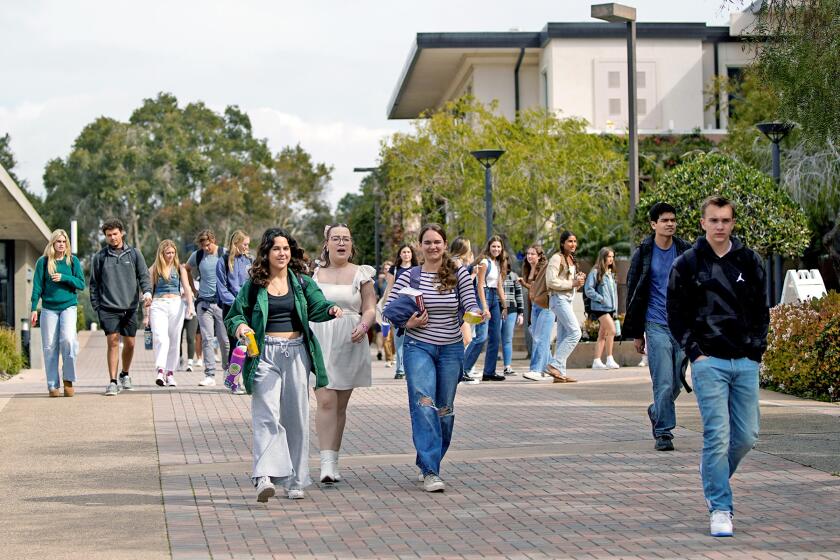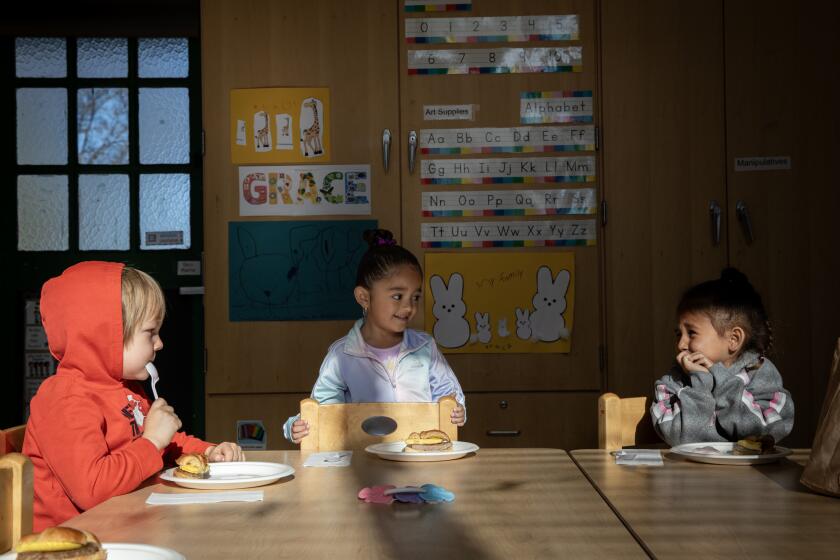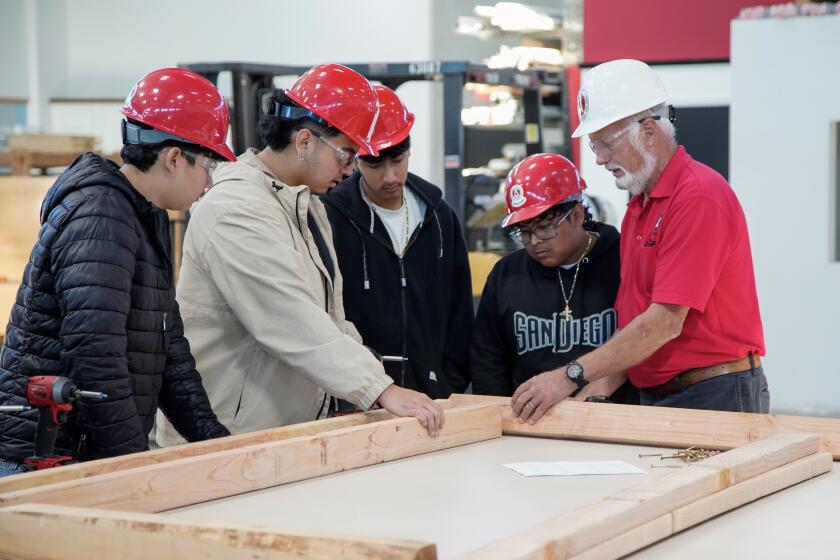Bright ideas for education
Education experts across the county and state weigh four big concepts

Ken Hughes has been teaching for 21 years, and there’s no topic in education that gets him more worked up than the achievement gap.
“It’s important to me; it’s important to all teachers. It’s embarrassing,” Hughes said. “It feels like an anchor that weighs down the teaching profession. You almost get those accusatory glares, like, ‘You must not be a very good teacher’ or ‘Systemically, what is wrong?’”
Actually, Hughes is considered to be an excellent educator; he was one of San Diego Unified School District’s teachers of the year in 2013. But cracking the generations-old enigma of helping students from disadvantaged backgrounds catch up and shine? That has been eluding him his whole career, which began in the Navy, took him to O’Farrell Charter School in southeast San Diego and now to Lewis Middle School in Allied Gardens.
And he’s far from alone in his frustration.
“This is the golden egg question,” Hughes said, a sentiment echoed by parents, teachers, administrators and politicians.
As students go back to school, education experts weigh in on four ideas that other states have been trying.
The ideas come from a list of noteworthy and trending policies observed by the Education Commission of the States, a nonpartisan school-policy tracking organization. Each responds to a different challenge, some timeless and some current: how to deal with low-performing teachers, how to best teach young children, how to energize sleepy teenagers, and, yes, even how to close the achievement gap.
IDEA #1: UNIVERSAL PRE-K
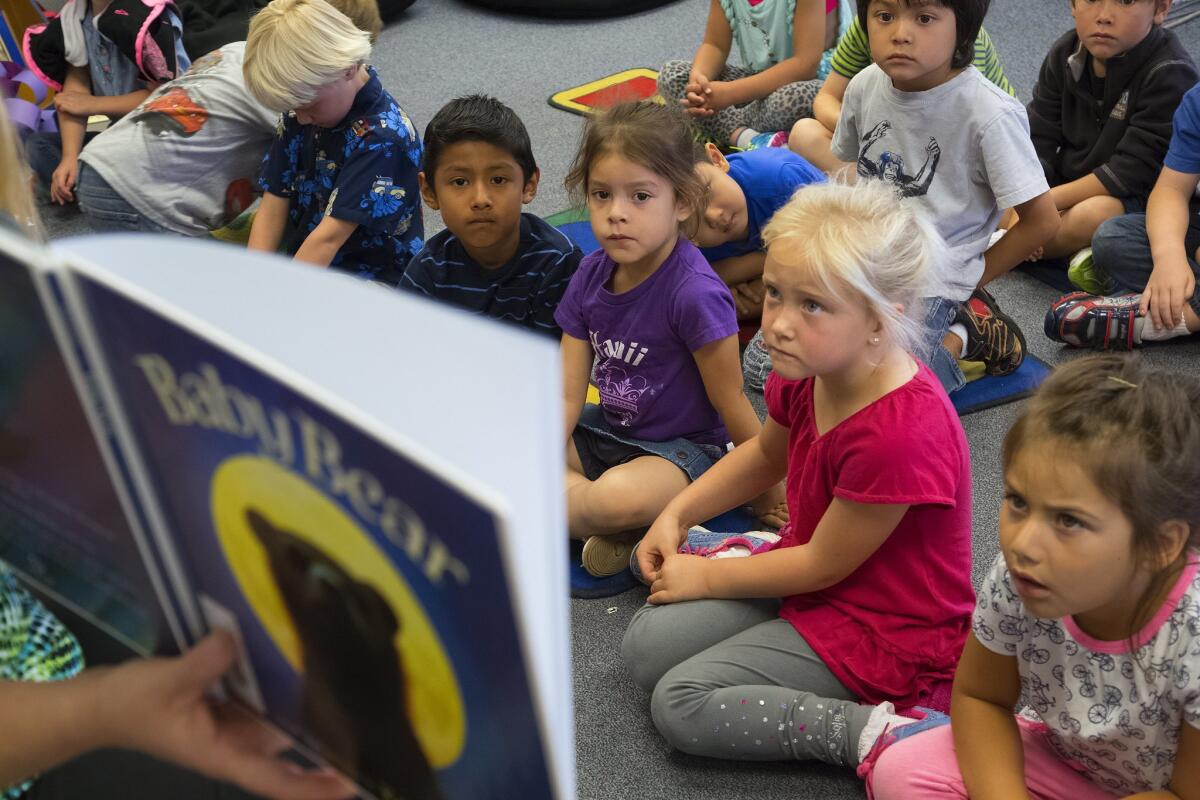
While some ideas are hotly debated, teachers, administrators and researchers agree that offering free education to children starting a year before kindergarten is a no-brainer — as long as the instruction is high quality. In recent years, states have been increasingly funding pre-K programs, according to the Education Commission of the States.
While some early childhood programs, both public and private, aren’t deemed effective in the long term, research over multiple decades has shown that quality early classroom education is better than starting school in kindergarten.
Randolph Ward, San Diego County superintendent of schools, cited studies that found a 7-to-1 return on public investment for money spent on quality preschool, a figure drawn from the work of Nobel Prize-winning economist James Heckman and used by the White House to support its push for early-childhood education.
“The payback is incredible,” Ward said.
Such investment leads to higher graduation rates, better employment prospects, and a lower chance of incarceration and teen pregnancy, among other benefits, according to researchers. Stimulating early brain development has the potential to narrow the divisions between poorer and better-off children.
“It is possible to remediate rather than to intervene early, but it is also much more costly,” Heckman wrote in a scholarly paper.
One dimension of quality is reaching the right populations, educators and researchers said. New York’s newly established universal pre-K program has earned mixed reviews because, according to a recent article in The Atlantic, it’s not actually helping the needy populations it aims to support.
San Diego Unified, which offers pre-K classes to 4-year-olds in families that meet income criteria, is facing a different kind of access challenge: It has empty seats, which the district has been working to fill by educating families about the program.
San Diego Unified Superintendent Cindy Marten said early-childhood education has been a priority since she took the position in 2013. Before creating a universal program, she said she wants to be sure current spots are filled.
A second aspect of quality: who is teaching, and what. Marten said she would rather have the district, not the state, enact rules for any potential universal pre-K program, because “some of the nuances in the state requirements” might not match “the nuances that we need at the local level, to do well,” she said.
Scott Himelstein, a former state education official and now head of the Institute for Entrepreneurship in Education at the University of San Diego, said that while pre-K in general is a good idea, an expanded or universal program would have to be done right. If it’s not staffed with quality teachers or doesn’t help the populations that need it, the investment “wouldn’t help.”
What does quality teaching mean in a classroom of 3- or 4-year-olds? Alison Wishard Guerra, co-editor of the forthcoming book “Children and Child Care: Relationships within Diverse Communities” and an associate professor of education studies at UC San Diego, said quality pre-K teaching nurtures children’s social and emotional development along with their academic growth.
At that level, the biggest impact happens when teachers model language, give quality feedback, introduce youngsters to new concepts, and help them make sense of ideas, their place in the world and the world around them through play.
“A developmentally appropriate approach allows for child interest and choices, and creates a warm and nurturing environment with positive regard for children, cultural sensitivity, and a positive relationship with others — peers and teachers,” Wishard Guerra said.
IDEA #2: A COMPREHENSIVE APPROACH
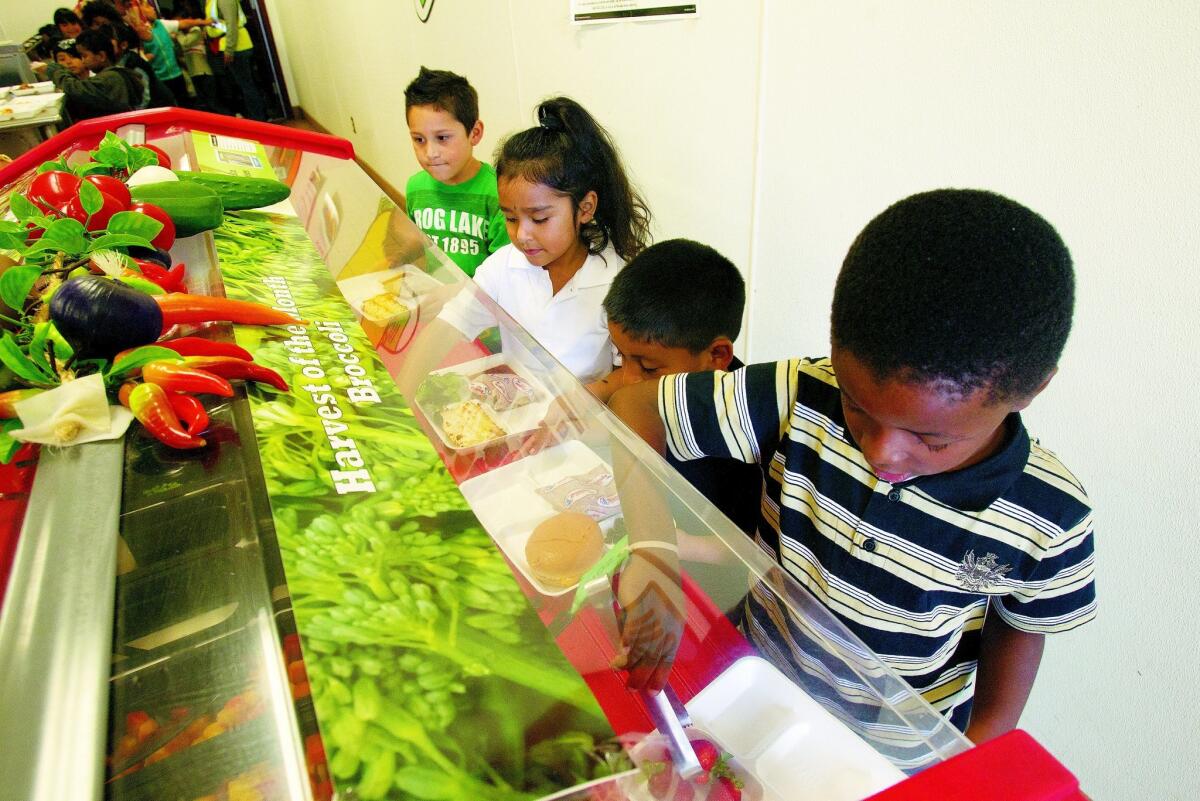
Kids who are hungry, sick, unsafe, unsupervised, or who face other problems will have a harder time focusing on school, let alone excelling. To address the achievement or opportunity gap, some states are looking beyond the classroom to satisfy kids’ basic needs in the hope they’ll catch up with their better-off classmates.
That’s another no-brainer, educators said.
“It sounds like a very simple thing, like to be against this would be to be against apple pie,” said San Diego Unified Superintendent Cindy Marten.
The hard part is knowing which problems to focus on, how to tackle them and who should be doing that work, she and others said.
According to the Education Commission of the States, four states — Connecticut, Massachusetts, Washington and Wisconsin — have tried to improve education outcomes for their neediest children by creating task forces or legislation. The initiatives focused on holistic solutions, including increasing affordable housing, helping students take advantage of federal lunch programs, finding ways to engage families, investing in early-childhood education and helping minority students stay in school.
Rather than debating what California should do, local experts offered their insights into how San Diego communities can improve schools, here and now.
One way is to measure results of programs, even when they’re not carried out by a district. Randolph Ward, the county’s superintendent of schools, said it’s important to commit to community-based solutions that are proven to work instead of programs that get launched but are never measured or tracked.
An idea that teachers, administrators and researchers repeated is that parents and community members need to be more involved.
“An excellent education system is all of ours to build, and it doesn’t just happen with the school district getting it right, or a teacher getting it right, or a principal getting it right,” Marten said. “It’s city government holding itself accountable, social service agencies holding (themselves) accountable, the community holding itself accountable. Not just the district alone.”
Debra Cruse, who teaches literacy in North County and won a teaching award this year, said any program that helps needy children should require a joint investment from families.
“It has to go two ways,” Cruse said. “I want to see a family that wants to participate with a student. … (Not) just, ‘We’re gonna give you this. Here’s a handout. Now you’re going to be fixed.’ It’s more than that. It’s a family commitment, a community commitment. They always say it takes a village. It totally does.”
Local educator Scott Himelstein has a theory for why parents and communities in California aren’t as involved as in other states: School boards and districts are too disjointed from city governments.
He said a turning point came in 1978 when Proposition 13 redirected local property taxes from local school districts to the state, from where they are redistributed.
Before then, “school board members set your property tax rates, and so you cared a lot who was on that board. You were watching how much things cost you, and how your school district spent your money.”
Now, important decisions seem remote and residents feel powerless, he said. “When you take a lot of the decision making and accountability away from the local community, sometimes what you get is apathy.”
How to counter this? Reform Proposition 13 and have local government agencies take a more active role in education. Not by paying lip service, but by finding concrete ways to solve goals. For example, if the district is equipping kids with Internet devices, could the city build hot spots where students need them? If students have trouble getting to school, could the public transit system be tweaked to improve access?
That kind of involvement would send a message to parents and community members that education is a real priority in San Diego, Himelstein said.
Finally, a different sort of challenge emerges when parties beyond schools and families get involved and have different ideas about what to improve and how.
Marten spent more than 10 years working in City Heights, the diverse, working-class neighborhood in central San Diego. Many nonprofits serve schoolchildren in City Heights, she said. Then mix in governments, police, health agencies, school districts and community groups. It’s like a bunch of people shining flashlights into a dark sky. That won’t light anything up. But if they point them all in the same direction, they’ll get “laser focus.”
The takeaway, she said: Organizations need to collaborate and coordinate efforts.
IDEA #3: STARTING SCHOOL LATER IN THE DAY
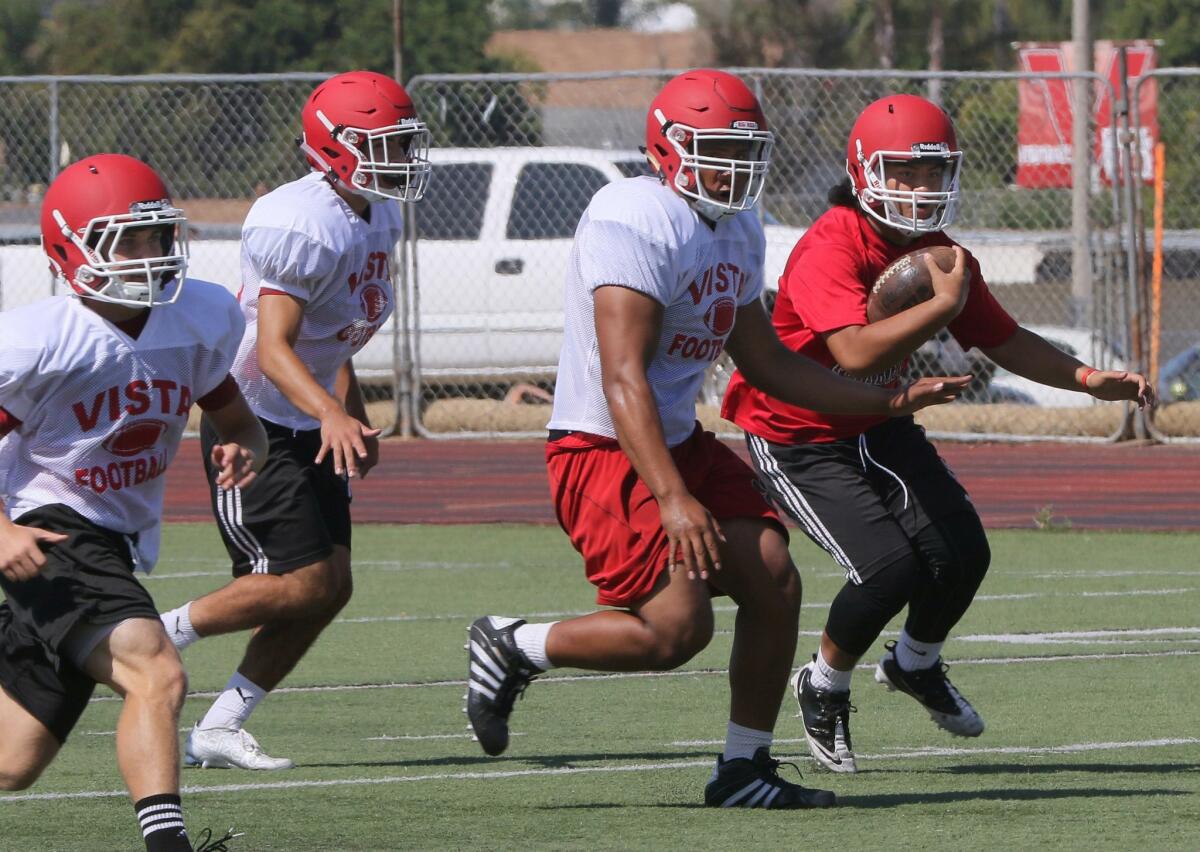
Jaime Enochs, who teaches English and film studies in San Diego and won a prestigious Milken Educator Award in 2009, understands why students stay up late: They’re addicted to screens, they have homework, they have responsibilities like jobs or helping out at home. But that doesn’t mean she likes it. “It’s much more difficult to have a discussion-based classroom when they’re not awake,” she said.
To perk up, they resort to caffeine-packed energy drinks, she said. “It’s not even coffee anymore. It’s Monster Energy. They’re just so bad for them. It’s how they stay awake,” Enochs said. For at least some of her students, more shut-eye would make a difference, so she strongly supports starting the day later.
It’s an idea endorsed by the American Academy of Pediatrics and supported by evidence that when schools start later, grades, attendance, health and test scores increase.
But San Diego Unified Superintendent Cindy Marten said changing the schedule would have “very significant pros” and “very significant cons.” Most high schools in the district start at 7:25 or 7:30 a.m. The district’s pediatrician gave several logistical reasons not to push the day later, Marten added. Athletes, whose practices and games can run late into the evening, would end their days even later. Other barriers: It would require changing schedules of bus routes and volunteers and would require after-school programs to start and finish later.
Marten bristled at the idea that the district wasn’t embracing later high school start times because it’s too tough to pull off.
“My reason would be more, ‘Does the community want it, is the community invested in it?’” The district seriously weighed the idea about 10 years ago, she said, and ever since, it’s proved to be polarizing. “It’s pretty much divided 50-50, and there’s not a right answer,” Marten said.
San Dieguito Union High School District, which starts in seventh grade, revamped its schedules to let students start and finish school at different times. Athletes or teens with after-school jobs or activities tend to start around 7:30 a.m., while the others start classes around 8:30 or 9 a.m., depending on the school, Superintendent Rick Schmitt said.
Debra Cruse, who teaches middle and high school in that district, said kids come in “sleepy-headed” and parents need to set structured bedtimes. “Who knows what’s going on at home?” she said. Her middle school classes at Earl Warren will start later this year, and even though she’s a morning person, she’s eager to see how that goes.
The district hasn’t tested the results of the later start times in schools where they were already rolled out. Feedback from students and parents has been good, Schmitt said. “What we have heard, seen and read is our families appreciate it.”
IDEA #4: LINK TEACHER TENURE TO PERFORMANCE
Nationwide, states and districts have been debating or dismantling teacher tenure, something that began in New Jersey almost 100 years ago as a way to protect against nepotism and random firings, according to the Education Commission of the States.
Now the trend is to link job security to performance, so that if teachers don’t improve after coaching or professional development, districts can fire them.
As of 2014, three states have decided to eliminate teacher tenure entirely (with the change either completed or under way), 16 states have made performance a component of tenure decisions (up from 10 in 2011) and 10 states forbid using tenure or seniority as a primary factor during layoff decisions, up from five in 2012, according to an ECS policy paper.
Scott Himelstein, head of the Institute for Entrepreneurship in Education at the University of San Diego, called tenure “one of the more important things, if not the most important thing, we have to address in education.” But “so far in California we’ve been unable to even have a conversation, serious conversations, with different sides sitting down on the issue of tenure.”
Teachers and other educators here are divided on this issue: Some want to hold on to the current system, while others would like to make it easier to replace teachers who don’t perform well after being given the opportunity to improve.
Randolph Ward, the county’s superintendent of schools, would take it a step further and make performance reviews integral to job security for everyone in education. “Not just teachers. The superintendents, the teachers, the classified staff, the support staff, principals, they should all be based on performance.”
But how do you measure performance? The absence of an answer that satisfies teachers is why so many of them want to hold on to tenure, said Jaime Enochs, a high school teacher. Among teachers, she said, “there’s a profound mistrust of the entities in charge of determining whether or not you’re a successful teacher.” She added she likes the idea of merit-based pay or tenure.
The trouble with using tests to evaluate teachers, Enochs said, is that students don’t always have an incentive to do well and they’re not equally good test takers or equally comfortable with computer testing tools. Another teacher said testing isn’t consistent — some years or topics get skipped.
Another problem (and here’s the crux, several teachers said) is that even without those other weaknesses, tests are not an effective comparison tool. Students might improve 1 percentage point at one school and 10 points at another, and in both cases that could be the result of great teaching. Kids’ scores alone don’t tell the whole story.
California has six standards for evaluating teachers and helping them improve, including seeing how their students perform on tests. The other five are: how well they connect with and support all of their students, how good they are at creating lessons that educate students with different needs and skills, how good they are at understanding and organizing the material they teach, how well they foster a quality learning environment, and how effective they are at developing over time as an educator.
These teachers said that a mix of assessments — including student test results, but also perhaps peer reviews or observation from supervisors — would give a more reliable picture.
Asked her view on seniority-based tenure, San Diego Unified Superintendent Cindy Marten said it’s not a “simple black and white” question and that she views both performance and seniority as linked to tenure.
Marten said she wants to help teachers grow. “I’m going to stay with the growth and development model,” she said. When teachers struggled and she was a principal, she worked with them to help them improve. She did the same thing when they excelled, she added.
Debra Cruse, a North County teacher, said failing teachers have a way of looking for an exit. “I’ve always believed that your job will either promote or expose you. The teachers that are not invested in what they are doing will be exposed,” she said. Eventually, they’ll leave, she added.
The teachers, administrators and researchers all said teachers need to have due process. But what is the best way to handle those who don’t leave, despite patience, training, due process, and time and resources to improve?
Lourdes Sanchez is a math teacher at Morse High School who has participated in several training programs she called “wonderful.” She recently won a statewide award for her work with underprivileged students. She said teacher training is essential, and the best programs take years, not weeks or months. But if a teacher still fails despite those efforts, it’s time to say goodbye, she said.
“The reason why you become a teacher is to meet the needs of the students,” Sanchez said.
Get Essential San Diego, weekday mornings
Get top headlines from the Union-Tribune in your inbox weekday mornings, including top news, local, sports, business, entertainment and opinion.
You may occasionally receive promotional content from the San Diego Union-Tribune.


